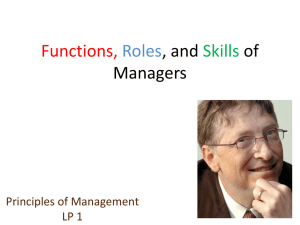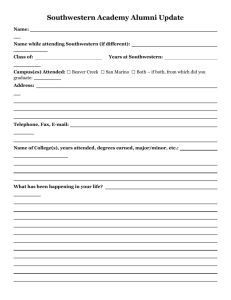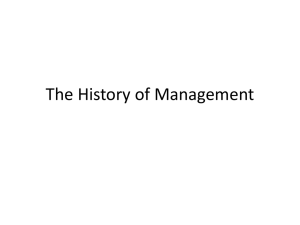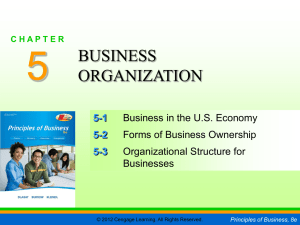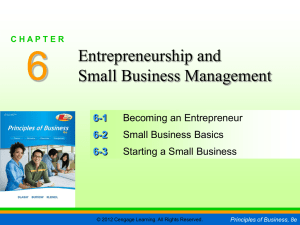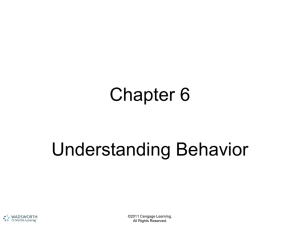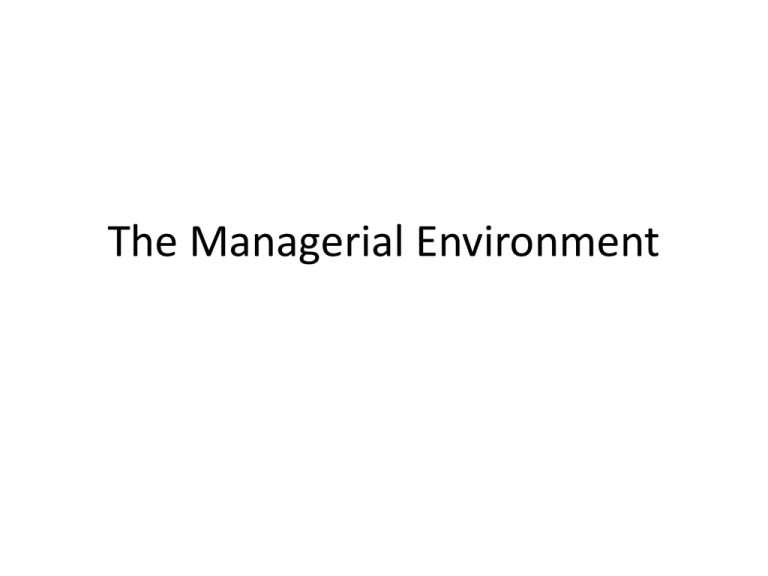
The Managerial Environment
4 Managerial Environments
•
•
•
•
Internal
External
Cultural
Ethics/Social Responsibility
The Internal Environment
Copyright © 2009 SouthWestern/Cengage Learning. All
rights reserved.
2–3
The Internal Environment
• Management and Culture
– Organizational culture
• The values, beliefs, and assumptions about appropriate
behavior that members of an organization share.
• Mission
– A organization’s purpose or reason for being.
• Top management’s responsibility is to develop a mission
with clear measurable objectives.
• Should be relevant to all stakeholders’ interests.
• Is an expression of the ends the organization strives to
attain.
Copyright © 2009 SouthWestern/Cengage Learning. All
rights reserved.
2–4
The Internal Environment (cont’d)
• Resources
–
–
–
–
Human resources
Physical resources
Financial resources
Informational resources
• Systems Process
– The method used to transform inputs into outputs.
– Process components
1.
2.
3.
4.
Inputs
Transformation
Outputs
Feedback
Copyright © 2009 SouthWestern/Cengage Learning. All
rights reserved.
2–5
Exhibit 2–2 ● The Systems Process
Copyright © 2009 SouthWestern/Cengage Learning. All
rights reserved.
2–6
The Internal Environment (cont’d)
• Structure
– The way in which resources are grouped to
effectively achieve the organization’s mission.
– Organizations structure resources to transform
inputs into outputs.
– All of an organization’s resources must be
structured effectively to achieve its mission.
Copyright © 2009 SouthWestern/Cengage Learning. All
rights reserved.
2–7
Copyright © 2009 SouthWestern/Cengage Learning. All
rights reserved.
2–8
The External Environment
• Task Factors
• General Factors
• Chaos and Interactive Management
The External Environment
• Task Factors
– Customers
• Their needs decide what products businesses offer.
– Competition
• Competitors’ business practices often have to be duplicated to
maintain customer value.
– Suppliers
• Poor quality suppliers mean poor quality products.
– Labor force
• Quality labor is needed to produce quality products.
– Shareholders
• The board of directors monitors management and provides
direction for the organization.
Copyright © 2009 SouthWestern/Cengage Learning. All
rights reserved.
2–10
The External Environment
• General Factors
– Society
• Businesses are pressured by societal forces to behave in an
acceptable manner.
– Technology
• Firms must stay current on technology to stay competitive and
provide customer value.
– The Economy
• Economic activity has both short and long-term effects on an
organization’s ability to provide customer value.
– Governments
• Policies, rules, and regulations affect what, how much, and how
business is conducted.
Copyright © 2009 SouthWestern/Cengage Learning. All
rights reserved.
2–11
The External Environment (cont’d)
• Chaos and Interactive Management
– Reactive managers
• Make changes only when forced to by external factors.
– Responsive managers
• Try to adapt to the environment by predicting and
preparing for change before they are required to do so.
– Interactive managers
• Design a desirable future and invent ways of bringing it
about by trying to prevent, not prepare for, threats and
to create, not exploit, opportunities.
Copyright © 2009 SouthWestern/Cengage Learning. All
rights reserved.
2–12
Copyright © 2009 SouthWestern/Cengage Learning. All
rights reserved.
2–13
Exhibit 2–5 ● The Organizational Environment
Copyright © 2009 SouthWestern/Cengage Learning. All
rights reserved.
2–14
Business Ethics
• Ethics
– The standards of right and wrong that influence
behavior.
– Government laws and regulations are designed to
govern business behavior.
• However, ethics go beyond legal requirements.
– Ethical concepts are culturally-bound.
• What is considered ethical in one country may be
unethical in another.
Copyright © 2009 SouthWestern/Cengage Learning. All
rights reserved.
2–15
Business Ethics (cont’d)
• Does Ethical Behavior Pay?
– Research shows a positive relationship between
ethical behavior and leadership effectiveness.
• Having strong ethics means having integrity, and
people trust others they believe have integrity.
– Unethical behavior creates a negative image of
big business.
• Mahatma Gandhi called business without morality a
sin.
Copyright © 2009 SouthWestern/Cengage Learning. All
rights reserved.
2–16
Factors Affecting Ethical Behavior
Personality Traits
and Attitudes
Moral
Development
Ethical
Behavior
The Situation
Copyright © 2009 SouthWestern/Cengage Learning. All
rights reserved.
2–17
How People Justify Unethical Behavior
• Moral Justification
– The process of reinterpreting immoral
behavior in terms of a higher purpose.
• Displacement of responsibility-blaming someone
else
• Diffusion of responsibility-when no one person is
held responsible
• Advantageous comparison-comparing oneself to
others who are worse
• Disregard or distortion of consequences-minimizing
the harm
• Attribution of blame-someone else was unethical so
I had to be unethical too.
• Euphemistic labeling-using “cosmetic” words to
make the behavior sound acceptable.
Copyright © 2009 SouthWestern/Cengage Learning. All
rights reserved.
2–18
Simple Guides to Ethical Behavior
• Golden Rule
– “Do unto others as you want them to do unto you.”
• Four-Way Test
1.
2.
3.
4.
Is it the truth?
Is it fair to all concerned?
Will it build goodwill and better friendship?
Will it be beneficial to all concerned?
• Stakeholders’ Approach to Ethics
– Creating a win-win situation for all relevant
stakeholders so that everyone benefits from the
decision.
Copyright © 2009 SouthWestern/Cengage Learning. All
rights reserved.
2–19
Social Responsibility
• Social Responsibility to Stakeholders
– The conscious effort to try to create a win-win
situation for all external stakeholders, as well as
internal stakeholders.
• Does It Pay to Be Socially Responsible?
– Social responsibility doesn’t guarantee or improve
profits, but scandals do hurt corporate
reputations.
Copyright © 2009 SouthWestern/Cengage Learning. All
rights reserved.
2–20
KEY TERMS
•
•
•
•
•
•
•
•
•
•
•
•
•
•
•
•
internal environment
organizational culture
mission
stakeholders
systems process
quality
customer value
total quality
management (TQM)
levels of culture
symbolic leaders
learning organization
external environment
Copyright © 2009 SouthWestern/Cengage Learning. All
rights reserved.
•
•
•
•
•
•
2–21
global village
ethnocentrism
international business
multinational
corporation (MNC)
global sourcing
joint venture
direct investment
ethics
stakeholders’
approach to ethics
social responsibility

